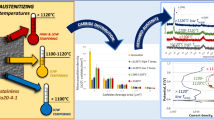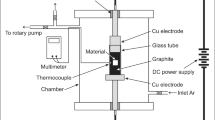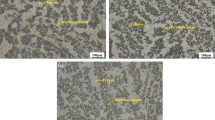Abstract
The effects of tempering temperature and carbon content on the stress corrosion cracking (SCC) behavior of high-strength CrMo steels in 3.5 pct NaCl aqueous solution have been studied by means of Auger electron spectroscopy (AES) and scanning and transmission electron micros- copy (SEM and TEM). Experimental results show that the specimens with higher carbon content and tempered at lower temperatures have a higher tendency for intergranular fracture and lower threshold stress intensity KISCC The SCC behavior is significantly affected by the distribution of carbide particles, especially carbide coverage on prior austenitic grain boundaries, through a carbide-matrix interface mechanism as the interface is the preferential site for the nucleation and propagation of microcracks because of its strong ability to trap hydrogen atoms. In low- temperature tempered states, there is the serious segregation of carbon in the form of carbide particles at prior austenitic grain boundaries, causing low-stress intergranular fracture. After tempering at high temperatures (≥400 °C), both the coalescence of the carbide particles at the grain boundaries and the increase of carbide precipitation within grains cause the decrease of the tendency for intergranular fracture and the rise of KISCC. The higher the carbon content in steels, the more the carbide particles at the grain boundaries and, subsequently, the higher the tendency for low-stress intergranular fracture. The carbide effect on KISCC makes an important contribution to the phenomenon that KISCC decreases with the rise of yield strength of the steels.
Similar content being viewed by others
References
W.W. Gerberich: inHydrogen in Metals, I.M. Bernstein and A.W. Thompson, eds., ASM, Metals Park, OH, 1974, pp. 115–47.
W.W. Gerberich and Y.T. Chen:Metall. Trans. A, 1975, vol. 6A, pp. 271–78.
E.A. Steigerwald and W.D. Benjamin:Metall. Trans. A, 1971, vol. 2A, pp. 606–08.
Zhen Wenlong:J. Chinese Soc. Corrosion Protection, 1984, vol. 4, pp. 287–94.
Zhen Wenlong, Zhu Guopei, Ouyang Huaijin, and Li Ge:Acta Metall. Sinica, 1986, vol. 22, pp. A275–82.
R.M. Magdowski and M.O. Speidel:Metall. Trans. A, 1988, vol. 19A, pp. 1583–96.
M.H. Peterson, B.F. Brown, R.L. Newbegin, and R.E. Groover:Corrosion, 1967, vol. 23, pp. 142–48.
G. Sandoz:Metall. Trans. A, 1972, vol. 3, pp. 1169–76.
A.W. Loginow and E.H. Phelps:Corrosion, 1975, vol. 31, pp. 404–15.
S.V. Nair and J.K. Tien:Metall. Trans. A, 1985, vol. 16A, pp. 2333–40.
S.K. Banerji, C.J. M Mahon, Jr., and H.C. Feng:Metall. Trans. A, 1978, vol. 9A, pp. 237–47.
C.L. Briant and S.K. Banerji:Int. Met. Rev., 1978, vol. 23, pp. 164–99.
N. Bandyopadhyay, Jun Kameda, and C.J. McMahon, Jr.:Metall. Trans. A, 1983, vol. 14A, pp. 881–88.
D. Lin, Y. Lan, and J. Wu:Metall. Trans. A, 1988, vol. 19A, pp. 2225–31.
Dongliang Lin and Jiansheng Wu:Acta Metall. Sinica, 1984, vol. 20, pp. A62–70.
R. Viswanathan and S.J. Hudak, Jr.:Metall. Trans. A, 1977, vol. 8A, pp. 1633–37.
B.D. Craig and G. Krauss:Metall. Trans. A, 1980, vol. 11A, pp. 1799–1808.
B.D. Craig:Metall. Trans. A, 1982, vol. 13A, pp. 907–12.
B.D. Craig:Metall. Trans. A, 1984, vol. 15A, pp. 565–72.
G. Sandoz: inStress Corrosion Cracking in High Strength Steels and in Titanium and Aluminum Alloys, B.F. Brown, ed., Naval Research Laboratory, Washington, DC, 1972, pp. 80–145.
Zhou Yu: M.S. Thesis, Harbin Institute of Technology, Harbin, People’s Republic of China, 1984.
Jing Tianfu: M.S. Thesis, Harbin Institute of Technology, Harbin, People’s Republic of China, 1983.
G. Sandoz:Metall. Trans., 1971, vol. 2, pp. 1055–63.
L.E. Davis, N.C. MacDonald, P.W. Palmberg, G.E. Riach, and R.E. Weber:Handbook of Auger Electron Spectroscopy, Physical Electronics Division, Perkin-Elmer Corporation, Eden Prairie, MN, 1978, pp. 5–15.
S. Craig, G.L. Harding, and R. Payling:Surf. Sci., 1983, vol. 124, pp. 591–601.
G.F. Li, R.G. Wu, and T.C. Lei: Harbin Institute of Technology, Harbin, People’s Republic of China, unpublished research, 1991.
G.M. Pressouyre:Metall. Trans. A, 1979, vol. 10A, pp. 1571–73.
G.M. Pressouyre:Metall. Trans. A, 1983, vol. 14A, pp. 2189–93.
J.P. Hirth:Metall. Trans. A, 1980, vol. 11 A, pp. 861–90.
Author information
Authors and Affiliations
Rights and permissions
About this article
Cite this article
Li, G.F., Wu, R.G. & Lei, T.C. Carbide- matrix interface mechanism of stress corrosion cracking behavior of high-strength CrMo steels. Metall Trans A 23, 2879–2885 (1992). https://doi.org/10.1007/BF02651766
Received:
Issue Date:
DOI: https://doi.org/10.1007/BF02651766




